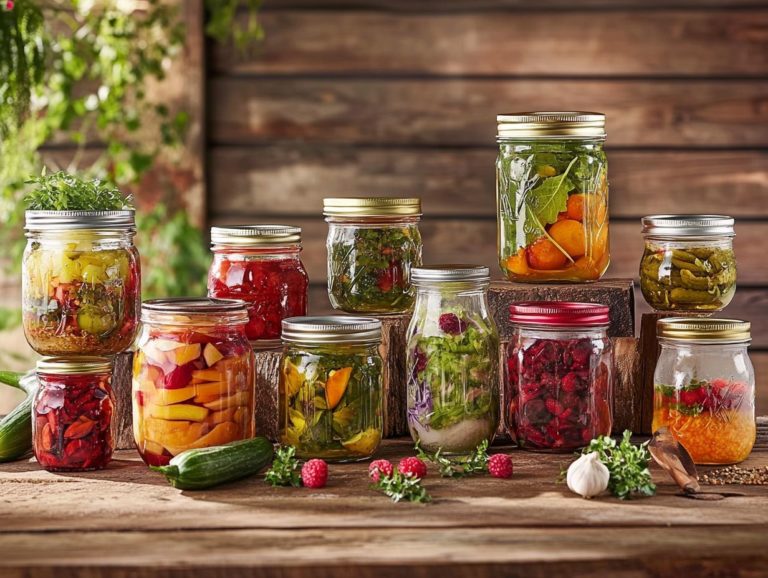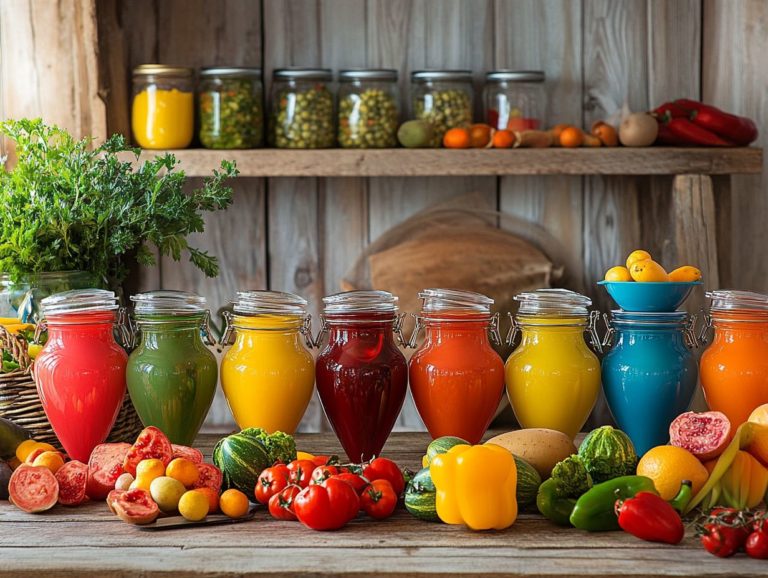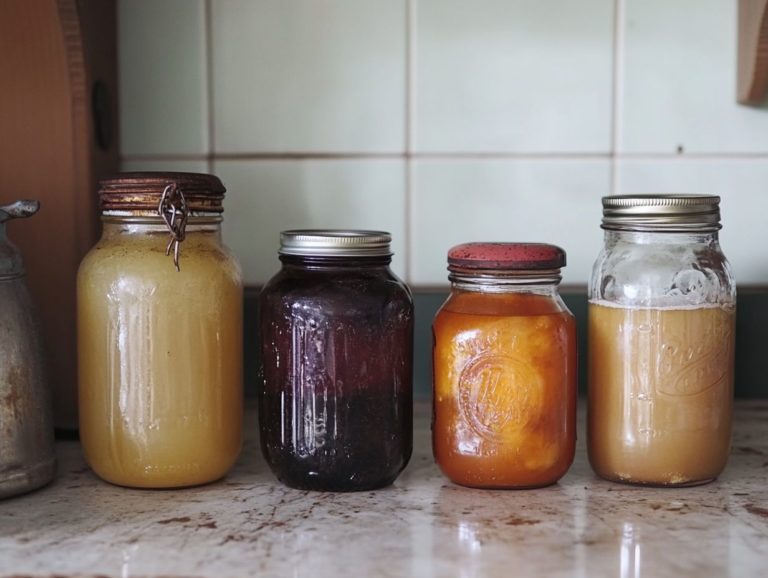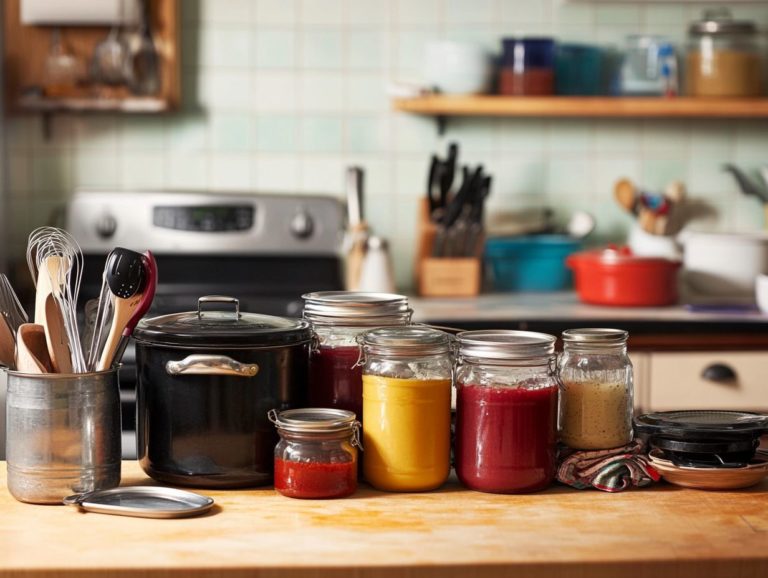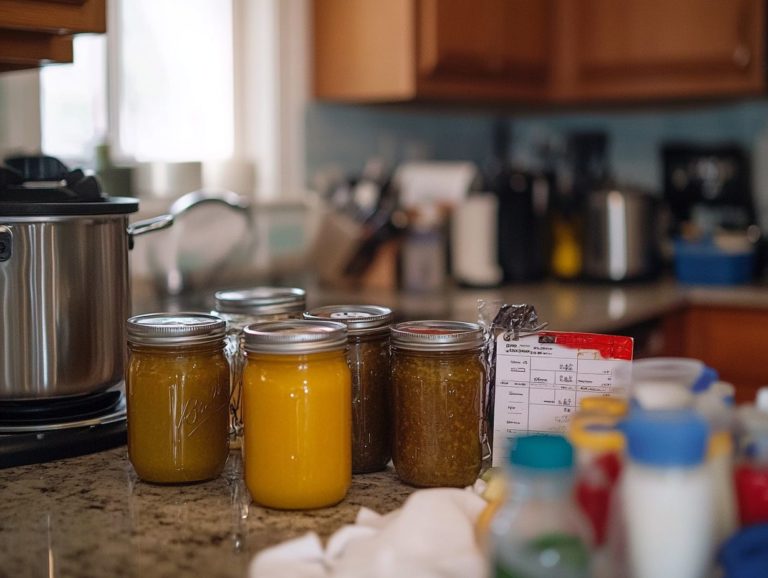Comparing Canning Methods: Equipment Needed
Canning is a time-honored method of preserving food that lets you enjoy seasonal flavors all year round. Whether you’re just starting out or have been canning for a while, grasping the essentials from the necessary tools to various canning techniques can truly enhance your home preservation endeavors.
Let s explore the must-have equipment for your canning adventure! This article dives into the required gear, the intricacies of water bath and pressure canning, along with some alternative methods worth your attention, providing you with a well-rounded guide to making informed canning decisions.
Dive in and uncover the best practices and benefits of each approach!
Contents
- Key Takeaways:
- What is Canning?
- Equipment Needed for Canning
- Water Bath Canning
- Process and Benefits
- Pressure Canning
- Other Canning Methods to Consider
- Frequently Asked Questions
- What are the essential equipment needed for canning?
- What is the difference between boiling water canning and pressure canning?
- Do I need to purchase all new equipment for canning every time?
- Can I use any type of jar for canning?
- Is it necessary to have a jar lifter?
- What equipment is needed for pressure canning?
Key Takeaways:
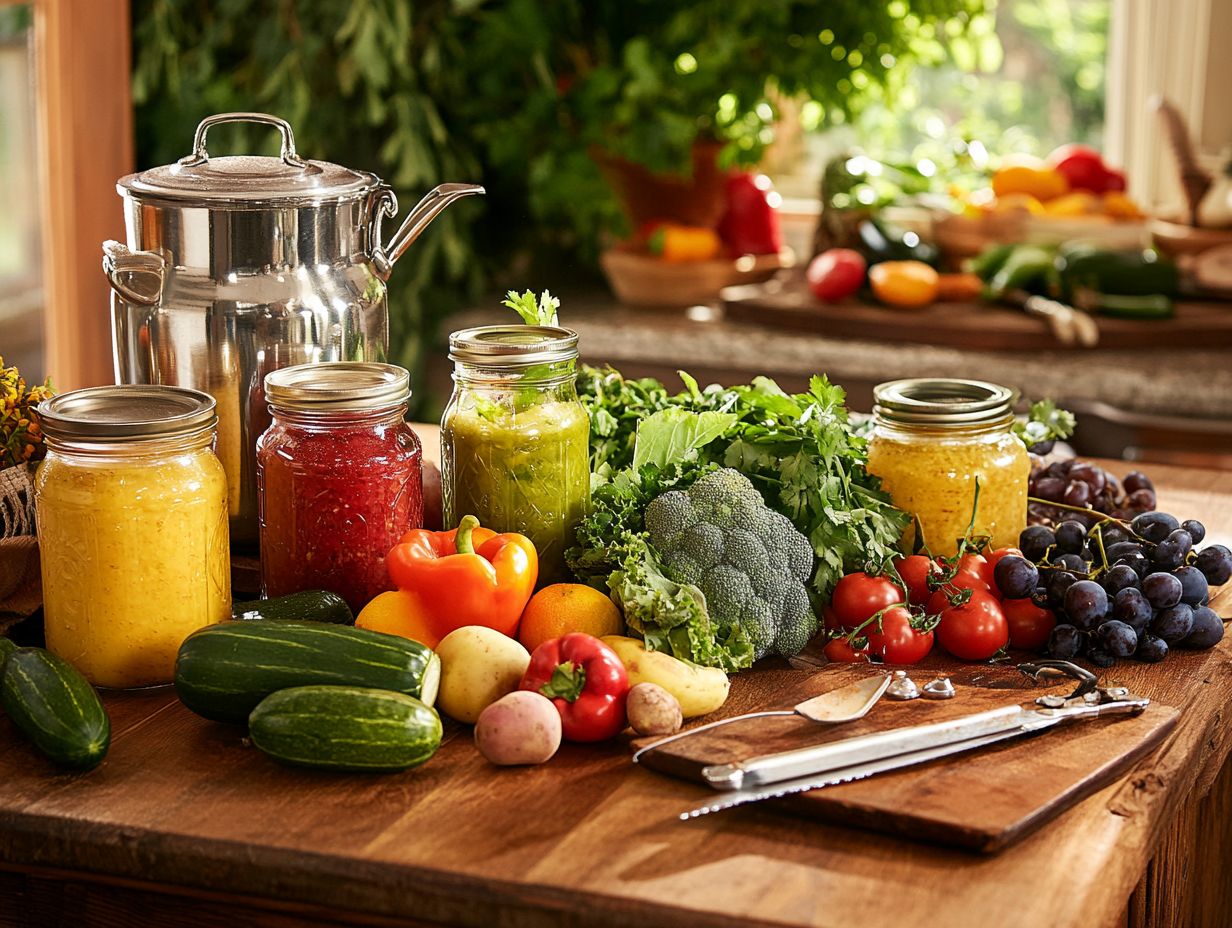
- Water bath and pressure canning are two popular methods for preserving food, but both require different equipment and techniques.
- Essential tools for canning include jars, lids, a canner, and various kitchen utensils. Pressure canning also requires a pressure canner and gauge.
- When choosing a canning method, consider the type of food being preserved, its acidity level, and the time and effort required for each method.
What is Canning?
Canning is a time-honored technique for preserving food. It involves sealing food in jars and applying heat to eliminate spoilage microorganisms and enzymes. This method allows you to safely store a diverse array of foods, from low-acid options like vegetables and meats to high-acid delights such as fruits and pickles.
By doing so, you extend their shelf life while preserving their nutritional value. Over the years, various canning methods, including pressure canning and boiling water canning, have emerged to adhere to USDA guidelines. This keeps your food safe. It also greatly reduces the risk of harmful bacteria that can cause serious illness, allowing you to enjoy your preserved foods with peace of mind.
Equipment Needed for Canning
To successfully embark on your canning journey, you must have the right equipment and tools at your disposal. Key items include canning jars, which come in various sizes and materials, along with essential tools like jar lifters, canning funnels, and headspace tools. For a deeper understanding of these tools, check out canning equipment reviews, as these tools are crucial for ensuring proper sterilization and sealing of the jars.
Depending on the types of foods you intend to preserve, whether low acid or high acid, you might also require specialized equipment like a pressure canner or a boiling water canner. To ensure you’re making the right choices, consider the key features to look for in canning equipment. Each of these is designed with specific processing times and safety measures, making them critical for your canning success.
Essential Tools and Supplies
Essential tools and supplies are vital for ensuring both the safety and efficiency of your canning process. Among these, the jar lifter is a crucial instrument, allowing you to grasp hot jars securely and protecting your hands from burns.
The canning funnel is another game-changer, optimizing the filling of jars to minimize mess and maximize precision—an absolute must for preserving the integrity of your contents. You’ll also want a headspace tool on hand to achieve that perfect air gap, which is essential for proper sealing. For more information, check out these essential tools for efficient canning to enhance the quality and longevity of your canned goods.
Food strainers help streamline ingredient preparation, ensuring consistent textures for sauces and jams. And don t overlook canning racks; they keep your jars steady during boiling, contributing to a smooth and safe canning experience overall.
Water Bath Canning

Water bath canning, often referred to as boiling water canning, is an esteemed method for preserving high-acid foods, including fruits and acidified tomatoes. This technique requires immersing jars of food in boiling water for a designated time, effectively eradicating spoilage microorganisms while beautifully preserving the food s quality and flavor.
Perfect for home canning aficionados, water bath canning follows USDA guidelines and is celebrated as a safe food preservation method when you use the right equipment and techniques. Understanding the essentials for canning kits is crucial to ensure a successful seal and prevent contamination.
Ready to start preserving your own food? Grab your jars and let s get canning!
Process and Benefits
Boiling water canning is a straightforward process, but it demands your attention to detail to ensure both food safety and quality. Start by preparing your high-acid foods and filling your sterilized jars. Leave some space at the top of the jars, known as headspace, to allow for food expansion during processing. Once sealed, place the jars into a boiling water bath for the recommended processing times, allowing the heat to penetrate and eliminate harmful microorganisms.
Not only does this method preserve food, but it also sparks culinary creativity! Get ready to enjoy delicious homemade treats all year long! It gives you the power to craft your own culinary delights that can be savored throughout the year.
To manage your time effectively, gather all necessary equipment in advance. Ensure your jars, lids, and utensils are sanitized and ready for action. After filling the jars, use a towel to wipe away any food residues from the rims this small step can prevent sealing issues.
Keep a close eye on the boiling water bath, adjusting the heat as necessary to maintain a steady boil throughout the process.
You can tweak recipes to suit your taste, whether that means adding a splash of vinegar for a tangy kick or a sprinkle of spices for a flavor boost, all while safeguarding the quality of the food.
By paying close attention to these safety precautions and steps, you can guarantee delectable, long-lasting results from your canning adventures.
Pressure Canning
Pressure canning stands as a crucial method for safely preserving low-acid foods, which simply cannot be adequately processed with water bath canning due to the potential risk of botulism spores.
This technique harnesses high pressure and temperature to effectively obliterate harmful bacteria, enzymes, and spoilage organisms, ensuring the safety and longevity of your food.
By utilizing either a dial gauge or a weighted gauge, pressure canners grant you the precise control needed to achieve the exact processing times and temperatures for various low-acid food items, including vegetables, meats, and soups.
Process and Advantages
The process of pressure canning involves several essential steps that guarantee the safety and quality of your preserved foods. Begin by preparing your low-acid foods and packing them into sterilized jars, being careful to maintain the recommended headspace. Once the jars are securely sealed, place them in the pressure canner. Adjust the heat to reach the required pressure and closely monitor the processing times as outlined in your canning recipes.
The benefits of pressure canning are significant; it enables you to safely preserve a wider array of low-acid foods while achieving a vacuum seal that enhances long-term storage. This meticulous method minimizes the risk of spoilage, allowing you to store various vegetables, meats, and soups safely for extended periods.
When setting up your canner, ensure the gasket a rubber or silicone ring that helps seal the canner tightly is clean and in excellent condition, as a proper seal is crucial for maintaining the right pressure. Safety tips to remember include always using a reliable pressure gauge and never leaving the canner unattended once it reaches the correct pressure.
By following these guidelines, you can confidently savor the flavors of home-cooked meals year-round, all while saving both time and money.
Other Canning Methods to Consider
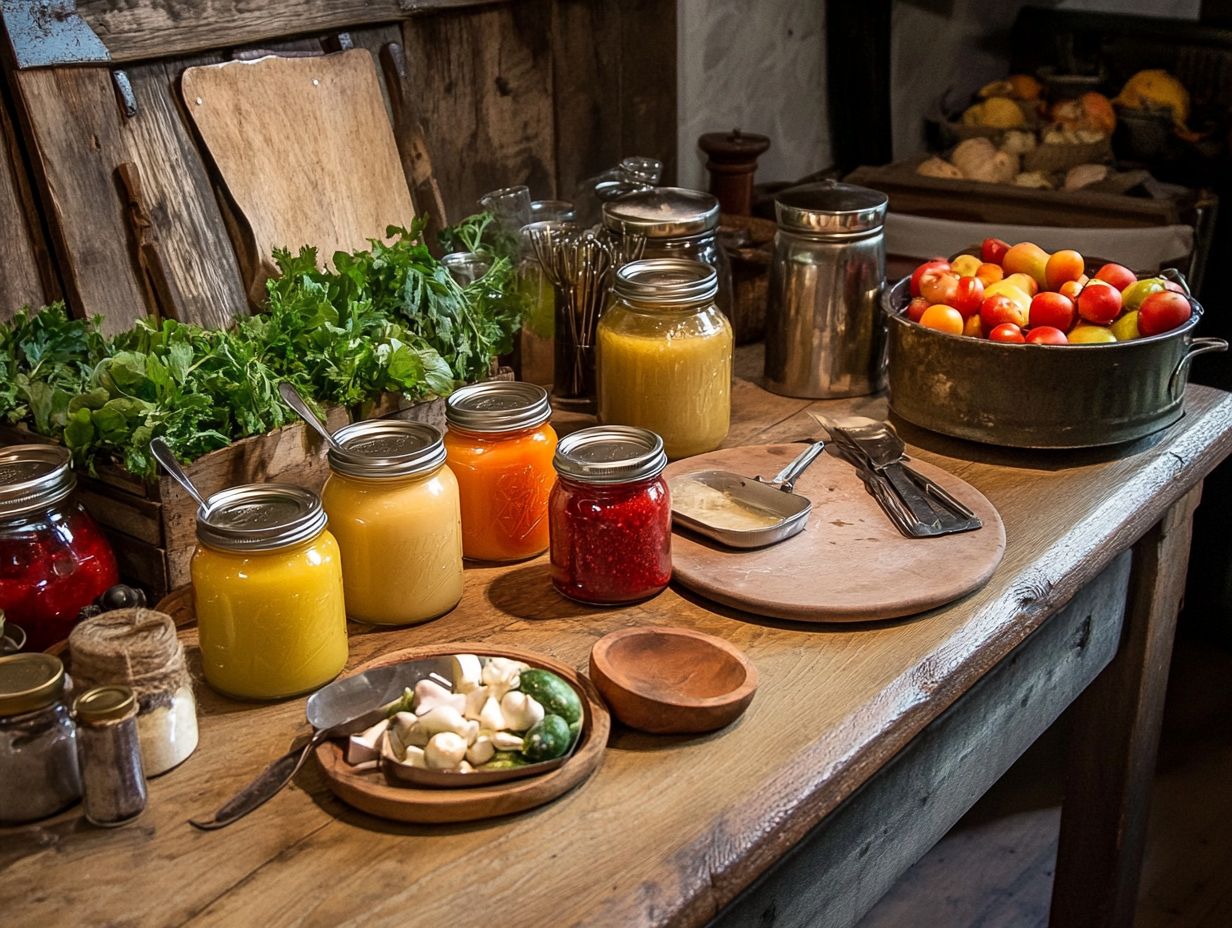
Besides boiling water canning and pressure canning, you have a range of other canning methods at your disposal, including essential canning equipment every beginner needs, each offering its own unique advantages and applications.
Take atmospheric steam canning, for instance this lesser-known technique operates much like pressure canning but utilizes steam to reach the necessary temperatures for preserving low-acid foods. By familiarizing yourself with the various canning methods available, you empower yourself to explore culinary creativity and select the best technique tailored to your specific preservation needs.
This ensures your pantry remains a diverse treasure trove filled with delicious, safe foods.
Try out these methods today and transform your pantry into a treasure trove of delicious, homemade foods!
Comparison and Pros/Cons
When evaluating various canning methods, weigh their pros and cons. Additionally, consider the essential equipment for home canning to identify which method aligns with your preservation needs.
Each method has special features tailored to different food types. For example, pressure canning is your go-to for preserving low-acid meats and vegetables. Boiling water canning shines with fruits, pickles, and jams. To learn more about these techniques, check out how to choose the right canning method. If you choose steam canning, be mindful of its specific time-temperature relationships to ensure effectiveness.
Food safety is very important. Improperly canned foods can harbor dangerous bacteria, so knowing which method to use is vital to help you feel comfortable. By considering factors such as food type, acidity, and your available equipment, you can make informed decisions that enhance both the safety and flavor of your preserved delights, especially by using the essential tools every home canner needs.
Frequently Asked Questions
What are the essential equipment needed for canning?
The essential equipment for home canning includes:
- Canning jars
- Lids
- Bands
- A canning pot
- A jar lifter
- A canning funnel
- Various canning tools
What is the difference between boiling water canning and pressure canning?
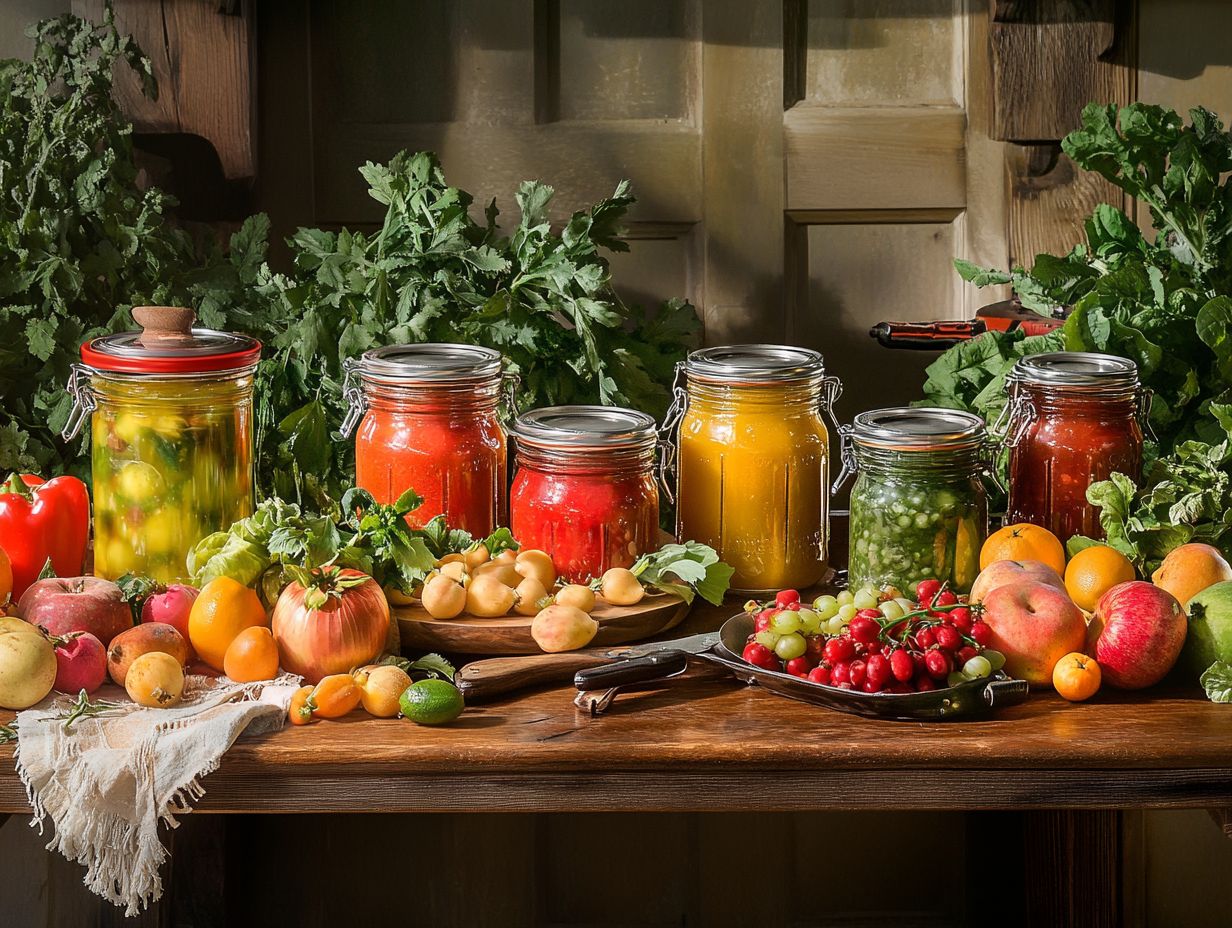
Water bath canning is a method used for high-acid foods, while pressure canning is used for low-acid foods. If you’re interested in making your own supplies, check out how to make your own canning equipment; pressure canning requires a pressure canner, while water bath canning only requires a large pot.
Do I need to purchase all new equipment for canning every time?
No, you do not need to purchase new equipment each time you can. Jars, lids, and bands can be reused as long as they are in good condition. However, other equipment, such as a canning pot and utensils, should be replaced if they become damaged or worn.
Can I use any type of jar for canning?
No, only jars specifically designed for canning should be used. These jars are made to withstand the high temperatures and pressures involved in canning, ensuring a safe end product.
Is it necessary to have a jar lifter?
Yes, a jar lifter, along with other canning tools, is important for canning. It allows you to safely remove hot jars from the canning pot without risking burns. It is not recommended to use tongs or other utensils for this task.
What equipment is needed for pressure canning?
To pressure can, you will need:
- A pressure canner
- Jars
- Lids
- A jar lifter
- A canning funnel
- A ladle
It is important to follow the processing times and methods set by USDA guidelines for safe and successful canning.

